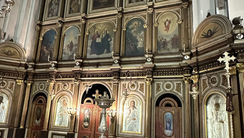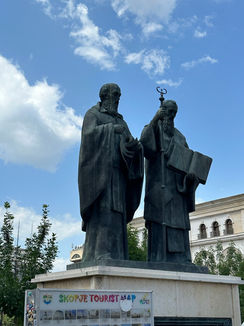Balkans Blast - A Journey of Adventure and Discovery
Montenegro, Albania, Kosovo and North Macedonia.
Driving in other countries can be an adventure and the Balkans were no different. The roads were exciting at times, but in most cases, well maintained and marked. Our plan was to loop through all 4 countries starting in Kotor, Montenegro, just south-east of Croatia.

Montenegro
Montenegro, just east of Croatia on the Adriatic coast. For reference, it’s smaller than CT. As it’s name implies it is the home of dark mountains. Kotor is a cool fortified town on Montenegro’s Adriatic coast, surrounded by limestone cliffs. It claims to be the southernmost fjord in Europe, with an impressive 66 miles of coastline surrounded by high limestone cliffs. As we entered the old town, beautiful winding cobblestone streets led us to quaint squares and lively cafes. Old churches and remnants of past centuries were at almost every turn.
A tour of Kotor bay took us to a few of the sites. Our Lady of the Rocks church, situated on a man made island made by fishermen who saw a vision. Fishermen began to pile rocks at the spot and over years an island was formed. Someone built a small baroque church to honor the fishermen and their vision. We passed the island of Mamula, which once served as a WW2 prison. It was difficult to fathom that the island was recently bought by a Chinese firm with ambitious plans to transform it into a 5-star resort. Wonder how future tourists will feel lounging in an old prison with walls so high that you have no view of the beautiful Adriatic! We entered a submarine cave, used by the Nazis to hide their vessels so narrow our boat had to back out rather than turn around. Must have been pretty cozy for a sub. Our cruise ended at a little cove with a swim in the refreshing and crystal-clear water - a delightful way to spend a morning.
While the boat tour had been interesting and refreshing, we set off to explore the old town on foot. Bear joined us as we wandered the cobblestone street However, he soon made it clear that he wasn’t a fan of bumpy streets! Mark rose to the challenge of climbing the city wall, up 1350 steps to reach St. John’s Fortress and was rewarded with a bird’s eye view of the town below and the Adriatic Sea beyond.
As we roamed the streets of Kotor, we sampled local fare and learned a bit about the town’s history, from its days as a maritime hub to its transformation into a tourist destination. A highlight was the interesting Church of St. Nicholas, a Serbian Orthodox church, originally built in 1166. The church as with much of the town had undergone several reconstructions over the years between wars and earthquakes. The latest reconstruction in the early 1900s resulted in a display of Byzantine art and an impressive array of silver plating. This church held significant importance in Kotor, where 70% of residents identify as Orthodox.
The drive itself into Durmitor National Park was an adventure, the craziest road we’ve ever driven, with one-lane roads winding through 30 hairpin turns and hand-cut tunnels - nerve wracking for sure, and unforgettable but glad we did it - once. Each turn revealed breathtaking views, making it a memorable journey through the park. Our modest Airbnb, nestled in a local neighborhood, turned out to be a simple flat. Any doubts about the accommodation vanished when we discovered a nearby pub offering delicious dishes of local lamb and trout.
Durmitor National Park lived up to its reputation, offering stunning landscapes in all directions. The highlight was the Tara River Gorge, a UNESCO site and the second deepest canyon after the Grand Canyon. In striking contrast to the GC, this canyon was tree-lined from top to bottom. The park offered an array of activities for the adventure seeker including zip-lining, rafting, hiking, and mountaineering but we were content with just the view.




After the rugged landscapes of Durmitor National Park, we traveled on to Bar, a coastal resort and seaport also in Montenegro. As we drove through the mountains we passed pockets of farmlands in the valleys. A memorable site was pointed haystacks - several feet tall to a point with a stick down the middle. Not quite sure why but they were all over. Haystacks certainly come in many shapes and sizes!
After the mountains, we headed back to the coastal town of Bar, Montenegro, near Lake Skadar, a glacial lake with lots of bird life. We laid low at the hotel because the heat was topping out at 104F. The hotel had a lovely pool and was well air conditioned. It also apparently had lots of rules. One of them was no dogs so we had to smuggle Bear in and out for walks. We’re usually pretty good at finding dog friendly accommodations and this one didn’t say either way but the long list of do’s and don’ts in the room clued us in. Other rules included no outside food, no guests to the room. Needless to say, Bear was very quiet and stealthy. The highlight of our time in Bar was supposed to be an early morning boat ride on Lake Skadar. The large lake, which straddles the border of Montenegro and Albania, is a haven for birdwatchers and nature enthusiasts. However, even with an 8am boat ride, the soaring temperatures seemed to have driven them into hiding. Guess they didn’t get the memo. Nevertheless, it was a peaceful early morning cruise.










Albania
Tirana, Albania is the capital of this interesting country. From 1945 to 1991, Albania had experienced a period of isolation, more isolated than North Korea today; they tried to be ultra Communists. No one and nothing came in or went out - even in and out of the other Soviet countries. The ruler, Enver Hoxha had 175,500 bunkers built throughout the country. Spying and suspicion dominated the culture. Supposedly 1 in 4 people were spying on someone else! Work camps and imprisonment were commonplace. The remnants of that era were evident in the cookie cutter concrete communist buildings all over the city and even in one of the museums we visited.
Yet, Tirana has embraced change and transformation in the decades since communism fell - after two economic collapses in the 90’s. Foreign investments had infused the city with a renewed sense of energy and vitality. We explored the bustling streets, admiring the colorful facades and vibrant street art that adorned the city. Interesting architecture is popping up all over. A visit to the Skanderbeg Square, with its namesake on horseback, a national hero who defeated the Ottoman Empire then held them at bay for 40 years, revealed a sense of pride in the nation’s history and identity.
Tirana’s people were warm and welcoming. On tours, we learned of the hard times overcome and how western products were introduced with some interesting anecdotes. It seems bananas and pineapples were baffling fruits to peel and eat when first introduced :-) The city’s progressive spirit was reflected in its burgeoning arts scene, with galleries and creative spaces popping up all over the city.















North Macedonia (size of Vermont)
Skopje,the capital city of North Macedonia, has been continuously occupied since the 2nd century AD, leaving us in awe of the ancient civilizations that once thrived here. However, devastating earthquakes over the centuries, the latest of which was in1963 (on the anniversary day we were there), have caused significant destruction of both historic sites and existing structures. The city’s attempts at rebuilding over the last several decades had yielded an interesting mix of communist buildings and foreign investments, earning Skopje the nickname “capital of kitsch.” It looks a bit like a mini-Las Vegas with a mini Arc de Triomphe next to a giant statue of Alexander the Great. As we strolled through the streets of Skopje, we encountered an eclectic blend of old and new. The city’s ambitious reconstruction projects were evident in the plethora of mismatched statues and grand buildings but the follow through on city maintenance and building upkeep was definitely missing.
One of the highlights was visiting the archaeological museum, which took us on a captivating journey through time. We marveled at ancient artifacts, intricate carvings, and statues that showcased the city’s historical significance and rich cultural heritage dating back to 12,000 BC. Another highlight was visiting Mother Tehersa’s birthplace - few know she was born there and lived there (though the Albanians claim her too since she also lived in Tirana).
Beautiful Lake Ohrid was the last stop on this amazing road-trip. This glacial lake, one of the oldest in Europe, straddles the border of North Macedonia and Albania. We stayed at the unforgettable Villa Bella Hotel, perched high on a hill overlooking the lake, reminding us of the idyllic landscapes of Santorini. As the sun set over the lake, we enjoyed a private dinner on the balcony of local trout and a bottle of rose from our Croatia days.









Kosovo (size of Delaware)
A quick day trip took us from Skopje to Pristina, the capital of Kosovo. A recommended bistro pub turned out to be a popular place. We were unknowingly seated at a few tables from none other than the Prime Minister of Kosovo, Albin Kurti and his security entourage. Guess he has good taste too!
Pristina is a city that has undergone a remarkable transformation in recent years. Its youthful energy and vibrant atmosphere were evident around the University of Kosovo, where the unique National Library stands as a symbol of hope and unity. The controversial architecture, featuring 99 white domes like traditional Albanian skull caps covered with metal fishing nets, sparked intriguing conversations about identity and national pride.
Conclusion
Our journey through Montenegro, Albania, Kosovo, and North Macedonia had been a whirlwind of adventure and discovery. All the countries lived through decades of communism and most emerged, mostly bloodlessly, through difficult economic times and are now works in progress. From the beautiful coast of Kotor to the captivating history of Tirana, the vibrant spirit of Pristina and the contrasting architecture of Skopje, each destination had left an indelible mark on our hearts.
Coming next, Bulgaria and Romania








































